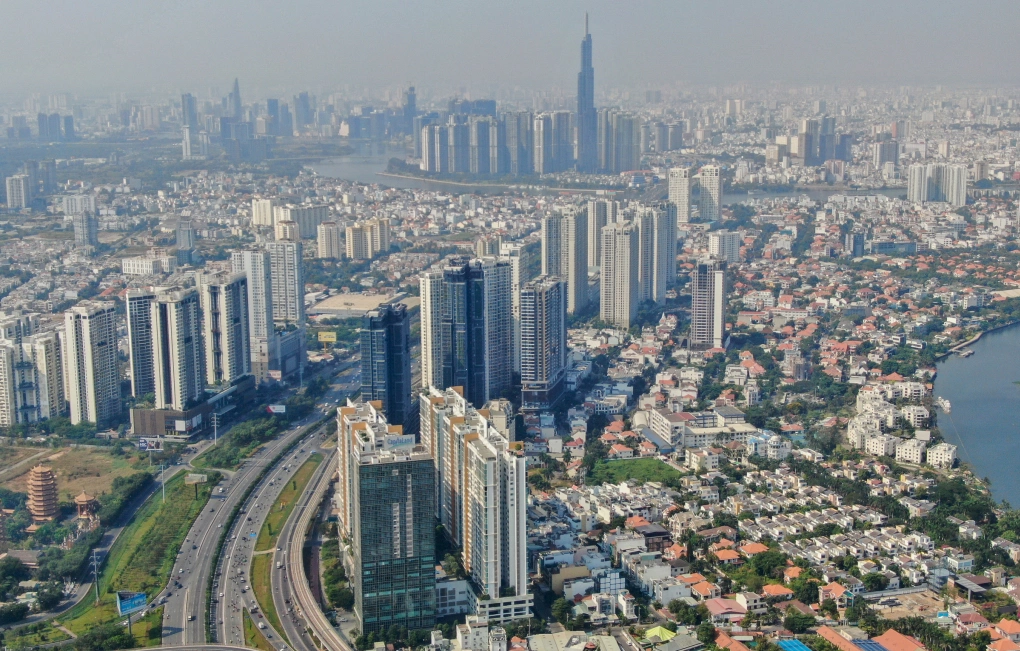VnExpress reports that inventory held by over 100 listed real estate companies in Vietnam has reached over 531,000 trillion VND, an 11% increase since the beginning of the year. This figure is the highest ever recorded. Many large developers, including Vinhomes, Novaland, Vingroup, Kinh Bac, and Khang Dien, reported record-high inventory levels in their financial statements.
At the end of Quarter II, Novaland held the largest inventory at 150,233 trillion VND, its highest to date. Land reserves and projects under construction comprised nearly 95% of this figure, with projects like Aqua City, Novaworld Ho Tram, and The Grand Manhattan leading the way. The remaining inventory consisted of completed properties and properties awaiting handover to customers.
Vingroup, a diversified conglomerate, holds the second-largest real estate inventory among listed companies, exceeding 98,600 trillion VND. Its subsidiary, Vinhomes, also reported a record high of over 80,200 trillion VND.
Nguyen Trong Dinh Tam, Deputy Director of ASEAN Securities Analysis, explained that real estate inventory (primarily apartments and condominiums) typically includes properties under construction, work-in-progress, completed properties for sale, and properties purchased for resale.
Properties under construction usually account for the largest portion. Given the typical 3-7 year development timeframe for projects, this inventory appears on balance sheets for multiple accounting periods.
Vo Hong Thang, Investment Director at DKRA Group, a real estate services company, views the high inventory levels at the end of Quarter II as a positive market indicator. This reflects developers having products ready for market and the financial resources to execute projects.
Thang noted that the real estate sector faced numerous challenges from 2022-2024, particularly regarding legal issues. High inventory during this period posed a risk to real estate companies.
By early 2025, authorities had addressed obstacles for numerous projects, creating market supply. This contributed to increased inventory as projects became market-ready but had not yet generated revenue.
In its economic and social report for the first 6 months of the year, the Ho Chi Minh City People's Committee (UBND TP HCM) reported reviewing 571 backlogged projects. Initially, 63 projects were resolved, unlocking over 86,800 trillion VND in investment capital and freeing up approximately 923 hectares of land.
Nguyen Trong Dinh Tam concurred, noting that sustained high inventory can indicate poor performance for commercial enterprises. However, for real estate companies, it's currently a positive sign.
The ASEAN Securities expert added that high inventory doesn't negatively impact the sector due to the current low-interest rate environment, benefiting both homebuyers and businesses. According to the State Bank of Vietnam, the average lending rate for new loans in the first 7 months was 6.38% annually, about 0.6% lower than at the end of 2024.
Tam also pointed to the State Bank's active injection of funds into the market as supportive of real estate companies. As of 30/6, total system credit reached 17.2 million trillion VND, a 9.9% increase from the end of 2024 and a 19.3% increase year-on-year, according to the State Bank of Vietnam. This is the highest growth rate since 2022.
Furthermore, Tam explained that the real estate sector is benefiting from positive business results and strong demand, mitigating the risk of high inventory. SSI Securities statistics show a 129.6% increase in net profit for real estate companies in Quarter II.
Despite the positive indicators in Quarter II, Vo Hong Thang believes more time is needed to observe inventory levels. "If inventory remains this high until the end of the year, it will no longer be a positive signal," he shared.
Nguyen Trong Dinh Tam maintains a positive outlook for the real estate sector in the second half of the year. He anticipates revenue from project handovers will contribute to 15-20% profit growth from 2025-2026.
 |
Eastern real estate along Hanoi Highway, Thu Duc City, 2/2024. *Photo: Quynh Tran* |
SSI Securities attributes the residential real estate market recovery in the first half of the year to improvements in both supply and demand. They believe supply growth stems from legal reforms, previously stalled projects, and newly approved projects, including social housing. Citing a CBRE report, SSI projects new apartment supply in Ho Chi Minh City (pre-merger) and Hanoi to reach 40,200 units in 2025 and 43,000 units in 2026, representing increases of 11% and 7% year-on-year, respectively.
In the long term, SSI sees growth potential in the real estate market due to high housing demand. They predict the current low urbanization rate will continue to rise rapidly, reaching 50% by 2030 with 1,000-1,200 urban areas.
Trong Hieu












